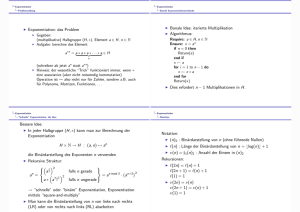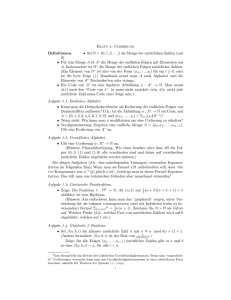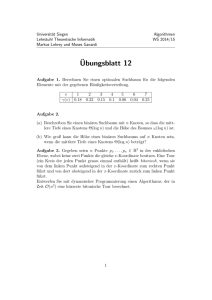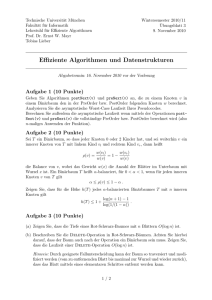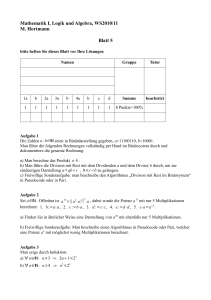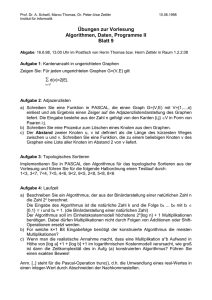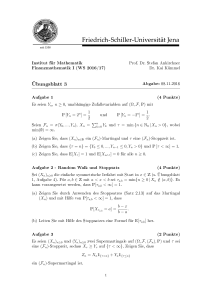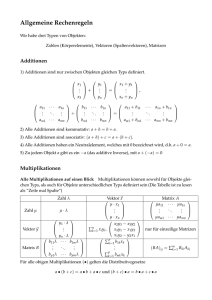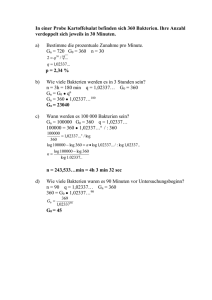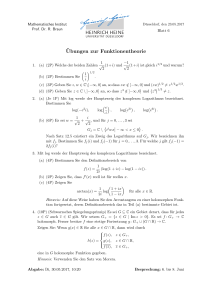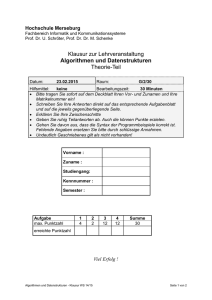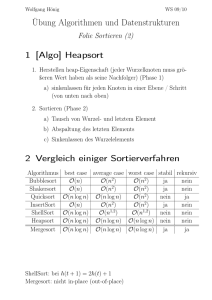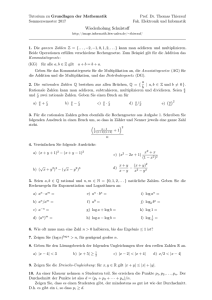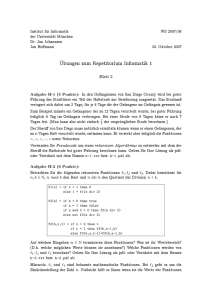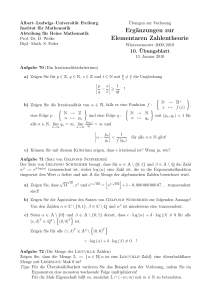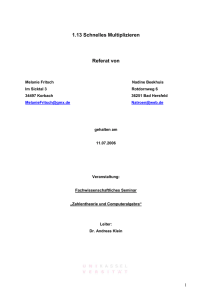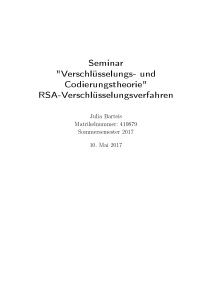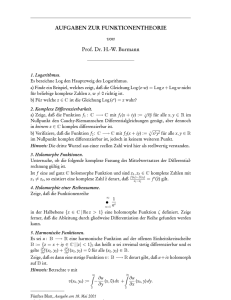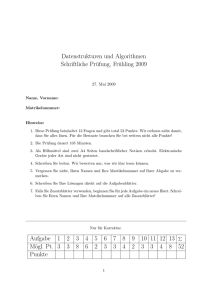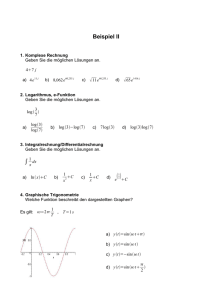Schnelle Exponentiation
Werbung
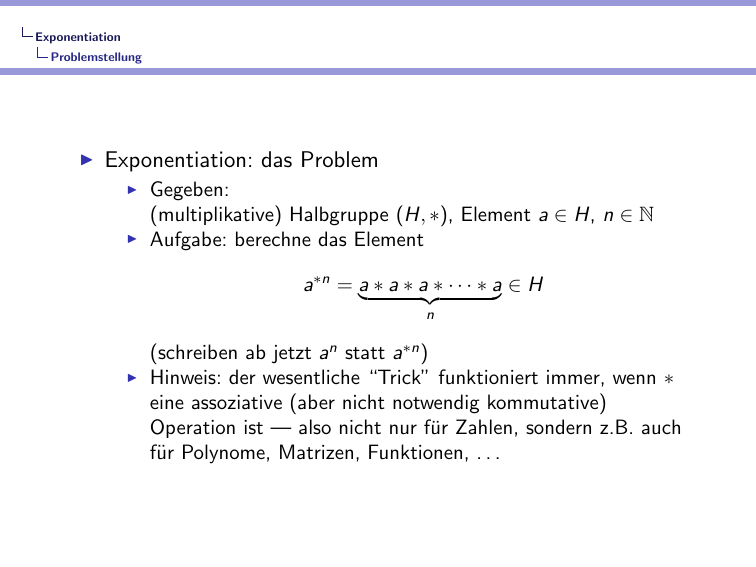
Exponentiation
Problemstellung
I
Exponentiation: das Problem
I
I
Gegeben:
(multiplikative) Halbgruppe (H, ∗), Element a ∈ H, n ∈ N
Aufgabe: berechne das Element
a∗n = |a ∗ a ∗ a{z∗ · · · ∗ a} ∈ H
n
I
(schreiben ab jetzt an statt a∗n )
Hinweis: der wesentliche “Trick” funktioniert immer, wenn ∗
eine assoziative (aber nicht notwendig kommutative)
Operation ist — also nicht nur für Zahlen, sondern z.B. auch
für Polynome, Matrizen, Funktionen, . . .
Exponentiation
Banale Exponentiationsmethode
I
I
Banale Idee: iterierte Multiplikation
Algorithmus:
Require: a ∈ H, n ∈ N
Ensure: x = an
if n = 0 then
Return(e)
end if
x ←a
for i = 1 to n − 1 do
x ←x ∗a
end for
Return(x)
I
Dies erfordert n − 1 Multiplikationen in H.
Exponentiation
“Schnelle” Exponentiation: die Idee
Bessere Idee:
I
In jeder Halbgruppe (H, ∗) kann man zur Berechnung der
Exponentiation
H × N → H : (a, n) 7→ an
die Binärdarstellung des Exponenten n verwenden
I
Rekursive Struktur:
n 2
a2
2
an =
a ∗ a n−1
2
falls n gerade
= an mod 2 · an÷2
2
falls n ungerade
→ “schnelle” oder “binäre” Exponentiation, Exponentiation
mittels “square-and-multiply”
I
Man kann die Binärdarstellung von n von links nach rechts
(LR) oder von rechts nach links (RL) abarbeiten
Exponentiation
Notation
Notation:
I
(n)2 : Binärdarstellung von n (ohne führende Nullen)
I
`(n) : Länge der Binärdarstellung von n = blog(n)c + 1
I
ν(n) = ]1 (n)2 : Anzahl der Einsen in (n)2
Rekursionen:
I
`(2n) = `(n) + 1
`(2n + 1) = `(n) + 1
`(1) = 1
I
ν(2n) = ν(n)
ν(2n + 1) = ν(n) + 1
ν(1) = 1
Exponentiation
“Schnelle” Exponentiation: LR-Beispiel
Beispiel n = 155 mit (155)2 = 10011011, `(155) = 8, ν(155) = 5
I
LR-Methode
(1)2
(2)2
(4)2
(9)2
(19)2
(38)2
(77)2
(155)2
=
=
=
=
=
=
=
=
1
10
100
1001
10011
100110
1001101
10011011
a1 = a
a2 = (a1 )2
a4 = (a2 )2
a9 = (a4 )2 ∗ a
a19 = (a9 )2 ∗ a
a38 = (a19 )2
a77 = (a38 )2 ∗ a
a155 = (a77 )2 ∗ a
erfordert 7 = `(155) − 1 Quadrierungen und 4 = ν(155) − 1
zusätzliche Multiplikationen, also insgesamt `(155) + ν(n) − 2
Multiplikationen
Exponentiation
“Schnelle” Exponentiation: RL-Beispiel
I
RL-Methode
(1)2
= 1
(3)2
= 11
(11)2
= 1011
(27)2
= 11011
(155)2 = 10011011
a1 = a
a2 = (a1 )2
a3 = a2 ∗ a
a4 = (a2 )2
a8 = (a4 )2
a11 = a8 ∗ a3
a16 = (a8 )2
a27 = a16 ∗ a11
a32 = (a16 )2
a64 = (a32 )2
a128 = (a64 )2
a155 = a128 ∗ a27
erfordert 7 = `(155) − 1 Quadrierungen und 4 = ν(155) − 1
zusätzliche Multiplikationen, also insgesamt `(155) + ν(n) − 2
Multiplikationen
Exponentiation
“Schnelle” Exponentiation: Aufwand
Aufwand:
I
M(n) : Anzahl der Multiplikationen (incl. Quadrierungen) in H zur
Berechung von an mittels LR- bzw. RL-Methode
I
Rekursion:
M(2n) = M(n) + 1
M(2n + 1) = M(n) + 2
M(1) = 0
M(n) = `(n) + ν(n) − 2
I
Folgerung:
I
Beweis (Induktion)
M(1) =0 =
1 + 1 − 2 = `(1) + ν(1) − 2
M(2n) =M(n)+1 = `(n)+ν(n)−1 = `(2n)+ν(2n)−2
M(2n+1) =M(n)+2 =
`(n)+ν(n) = `(2n+1)+ν(2n+1)−2
I
Also gilt insbesondere:
blog nc ≤ M(n) ≤ 2blog nc d.h. M(n) ∈ Θ(log n)
Exponentiation
“Schnelle” Exponentiation: Zitate aus TAOCP
Abbildung: Knuth, TAOCP vol.2, ch. 4.6.3 (LR-Methode)
Exponentiation
“Schnelle” Exponentiation: Zitate aus TAOCP
Abbildung: Knuth, TAOCP vol.2, ch. 4.6.3 (LR vs. RL)
Exponentiation
“Schnelle” Exponentiation: Zitate aus TAOCP
Abbildung: Knuth, TAOCP vol.2, ch. 4.6.3 (RL)
Exponentiation
“Schnelle” Exponentiation: Zitate aus TAOCP
Abbildung: Knuth, TAOCP vol.2, ch. 4.6.3 (RL)
Exponentiation
“Schnelle” Exponentiation: Zitate aus TAOCP
Abbildung: Knuth, TAOCP vol.2, ch. 4.6.3 (RL)
Exponentiation
“Schnelle” Exponentiation: iteratives Programm
Require: a ∈ H, n ∈ N
Ensure: x = an
x ←e
A←a
N←n
while N 6= 0 do
if N is even then
A←A∗A
N ← N/2
else {N is odd}
x ←x ∗A
N ←N −1
end if
end while
Return(x)
Exponentiation
“Schnelle” Exponentiation: rekursives Programm
I
Maple-Programm (rekursiv)
power := proc (a,n::nonnegint)
if n=0 then RETURN(1)
else t := power(a,iquo(n/2))^2;
if odd(e) then t := t*a fi;
RETURN(t)
fi;
end;
(Q)
(M)
Exponentiation
“Schnelle” Exponentiation: Anwendung
Zur Anwendung:
I
Knuth (TAOCP, vol2., ch. 4.6.3) diskutiert, wann man “binäre”
(“schnelle”) Exponentiation verwenden sollte und wann nicht!
I
Zitat: The point of these remarks is that binary methods are nice,
but not a panacea. They are most applicable when the time to
multiply x j · x k is essentially independent of j and k (for example,
when we are doing floting point multiplication, or multiplication
modulo m); in such cases the running time is reduced from order n
to order log n.
I
Vorsicht! wenn der Aufwand für die Multiplikation x j · x k
proportional zu j · k, als ist (Integer- und Polynommultiplikation!),
also quadratisch mit der Anzahl der Ziffern- bzw.
Koeffizientenoperationen wächst, kann der Aufwand für die
“banale” Methode von der gleichen Grössenordnung wir für die
“schnelle” Methode sein — oder sogar schlechter!
Exponentiation
“Schnelle” Exponentiation: Anwendung
I
Anwendungszenario: Exponentiation in Zm
(a, n, m) 7→ an mod m
I
I
Maple-Programm (rekursiv)
modpower := proc (a,n,m)
if n=0 then RETURN(1)
else t := modpower(a,iquo(n/2),m)^2; (Q)
if odd(n) then t := t*a mod m fi;
(M)
RETURN(t mod n)
fi;
end;
benötigt (etwa) log n-maliges Quadrieren und höchstens log n
weitere Multiplikationen von log m-bit Zahlen und log n
Reduktionen modulo m von 2 log m-bit-Zahlen,
also insgesamt
2
einen Aufwand O log n · (log m) gemessen in
bit-Operationen.
Exponentiation
“Schnelle” Exponentiation: Anwendung
I
Umkehrabbildung: diskreter Logarithmus
(a, an mod m, m) 7→ n
I
I
Hierfür ist bis heute kein effizienter Algorithmus bekannt!
Die besten bekannten Algorithmen haben gleiche Komplexität
wie die besten Algorithmen für die Faktorisierung von m
Zahlenbeispiel: a, n, m in der Grössenordnung 10200
I
I
schnelle Exponentiation erfordert etwa 3000 Multiplikationen
von 200-digit-Zahlen und 3000 Reduktionen modulo m von
400-digit-Zahlen
die Berechnung des diskreten Logarithmus “brute-force” würde
etwa 10200 Multiplikationen und Reduktionen modulo m
erfordern
Exponentiation
“Schnelle” Exponentiation: Anwendung
I
I
Anwendungsszenario: schnelle Berechung C-rekursiver Folgen
Kanonisches Beispiel: Fibonacci-Zahlen
I
1
Idee: mit F =
gilt
0
fn
fn−1 + fn−2
1
=
=
fn−1
fn−1
1
also
1
1
fn
fn−1
I
I
= F n−2
1
fn−1
fn−1
=F
0
fn−2
fn−2
f2
1
= F n−2
f1
1
Die Berechnung von fn mittels iteriertem Quadrieren der
Matrix F benötigt 13 · blog(n − 2)c + 12 · ν(n − 2) − 10
arithmetische Operationen (Additionen, Subtraktionen,
Multiplikationen, Divisionen durch 2 , siehe Heun, GA)
Dies kann noch etwas verbessert werden, wenn man ausnützt,
dass die Potenzen von F symmetrische Matrizen sind
Exponentiation
“Schnelle” Exponentiation: Anwendung
I
Gofer-Programm zur Berechnung der Fibonacci-Zahlen mittels
schneller Exponentiation von Matrizen (Heun, GA)
I
I
Siehe Materialien zur Vorlesung für Laufzeitanalysen und
gemessene Laufzeiten verschiedener Algorithmen zur
Berechnung von Fibonacci-Zahlen
Die Methode lässt sich generell für C-rekursive Folgen
anwenden und liefert Verfahren logarithmischer (in n)
Komplexität
Exponentiation
Additionsketten
Hinweis:
I Das Problem, an in einer Halbgruppe möglichst effizient zu
berechnen, hat etwas mit dem Problem der sog.
Additionsketten zu tun.
I Eine Additionskette für n ∈ N ist eine Folge
1 = a0 , a1 , a2 , . . . , ar = n
von ganzen Zahlen mit der Eigenschaft
ai = aj + ak wobei j ≤ k < i (1 ≤ i ≤ r )
(straight-line-Programm mit Addition als einziger Operation)
1
2
3
6
12
15
27
39
78
79
Exponentiation
Additionsketten
I
LR-Additionskette für n = 155
1
I
2
4
8
9
18
19
38
76
77
154
155
16
27
32
64
128
155
RL-Additionskette für n = 155
1
2
3
4
8
11
Exponentiation
Additionsketten
I
I
I
Das Problem, die Länge L(n) kürzester Additionsketten für
gegebenes n zu bestimmen, ist sehr schwierig!
LR- und RL-Additionsketten sind nicht immer optimal!
1
2
3
6
7
14
15
1
2
3
4
7
8
15
1
2
3
6
12
15
Berühmte Vermutung (Scholz, Brauer, 1937,1939):
L(2n − 1) ≤ n − 1 + L(n)
I
Mehr darüber in ch. 4.6.3 von TAOCP!
